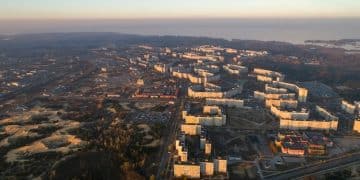How US Political Figures Tackle Income Inequality

Political figures in the United States are addressing income inequality through various policy proposals, including tax reforms, increasing the minimum wage, investing in education and job training programs, and expanding access to affordable healthcare.
Income inequality has become a prominent issue in the United States, capturing the attention of voters, economists, and, crucially, political figures. Understanding how these leaders are addressing this complex challenge is essential for anyone seeking to grasp the current political landscape. This article explores the diverse approaches employed by political figures in the US to combat income inequality.
Understanding Income Inequality in the US
Income inequality refers to the extent to which income is distributed unevenly among a population. In the United States, this gap has been widening for decades, with the wealthiest individuals accumulating a disproportionate share of the nation’s income. Recognizing the scope and impact of this inequality is the first step towards addressing it effectively.
Several factors contribute to income inequality, including technological advancements, globalization, changes in the labor market, and shifts in tax policies. Political figures often emphasize different aspects of these causes when proposing solutions.
The Growing Divide: Key Statistics
The statistics surrounding income inequality in the US are stark. Understanding these figures helps to contextualize the policies proposed by political figures.
- The top 1% of earners hold a significant portion of the nation’s wealth, far exceeding the share held by the bottom 50%.
- Wage stagnation for middle- and lower-income workers has been a persistent trend.
- Racial and gender disparities exacerbate income inequality.
Political figures use these statistics to underscore the urgency of the issue and build support for their proposed solutions. They may highlight specific demographics or regions most affected by income inequality to tailor their policy proposals.

In conclusion, understanding the multifaceted nature of income inequality is crucial for grasping the various approaches taken by political figures to address this pressing issue.
Tax Policy and Income Redistribution
One of the most direct ways political figures address income inequality is through tax policy. Tax reforms can redistribute wealth by increasing taxes on higher earners and providing tax relief to lower- and middle-income households. The specific proposals vary widely, reflecting different political ideologies.
Proponents of progressive taxation argue that those who can afford to pay more should contribute a larger share to support public services and reduce income disparities. Opponents, however, contend that high taxes can stifle economic growth and discourage investment.
Differing Tax Reform Proposals
Political figures propose various tax reforms aimed at addressing income inequality. These proposals often include changes to income tax rates, capital gains taxes, and estate taxes.
- Increasing the top marginal income tax rate for high-income earners.
- Reforming capital gains taxes to equalize rates with ordinary income.
- Strengthening the estate tax to prevent dynastic wealth accumulation.
These proposals aim to generate revenue that can be used to fund programs benefiting lower- and middle-income families, such as education, healthcare, and affordable housing. The debate over these tax reforms is a central component of the broader discussion on income inequality.
In summary, tax policy is a powerful tool for addressing income inequality, but the optimal approach remains a subject of intense debate among political figures with differing economic philosophies.
Minimum Wage and Living Wage Initiatives
Raising the minimum wage is another policy tool frequently advocated by political figures to combat income inequality. Proponents argue that a higher minimum wage can lift low-wage workers out of poverty and reduce the gap between the highest and lowest earners.
Opponents, however, caution that increasing the minimum wage could lead to job losses as businesses adjust by reducing their workforce or raising prices. The debate often centers on the trade-off between providing a living wage and maintaining employment levels.
State and Local Minimum Wage Laws
Many states and cities have enacted minimum wage laws that exceed the federal minimum wage. These initiatives reflect a growing recognition of the need to provide a living wage to workers in high-cost areas.
- States like California and New York have gradually increased their minimum wages to $15 per hour.
- Some cities have implemented even higher minimum wages to account for local living costs.
- These state and local initiatives serve as models for federal minimum wage reform.
Political figures often champion these state and local successes as evidence that raising the minimum wage can be an effective way to reduce income inequality without causing widespread job losses.
In conclusion, minimum wage and living wage initiatives remain a contentious but crucial element of the policy toolkit for addressing income inequality in the United States.
Education and Job Training Programs
Investing in education and job training programs is a long-term strategy often supported by political figures to address income inequality. By equipping individuals with the skills and knowledge needed to succeed in the modern economy, these programs can help to level the playing field and create pathways to upward mobility.
These programs can also help to address the skills gap, where employers struggle to find qualified workers for available jobs. By providing targeted training in high-demand fields, education and job training initiatives can boost employment rates and increase earnings for lower- and middle-income workers.
- Expanding access to early childhood education, such as Head Start programs.
- Increasing funding for public schools, particularly in low-income communities.
- Offering vocational training and apprenticeships in high-growth industries.

Political figures often highlight the importance of these programs in creating a more inclusive and equitable economy. They may propose specific initiatives, such as tuition-free community college or expanded Pell Grants for low-income students.
In summary, education and job training programs offer a sustainable approach to addressing income inequality by investing in human capital and promoting long-term economic opportunity.
Healthcare Access and Affordability
Access to affordable healthcare is increasingly recognized as a critical factor in addressing income inequality. Medical expenses can be a significant financial burden for lower- and middle-income families, and lack of insurance can lead to delayed or forgone care.
Political figures propose various approaches to expand healthcare access and affordability, ranging from strengthening the Affordable Care Act (ACA) to implementing universal healthcare systems.
Different Approaches to Healthcare Reform
The debate over healthcare reform is a central battleground in the fight against income inequality. Political figures advocate for different approaches based on their ideological perspectives and policy priorities.
- Strengthening the Affordable Care Act (ACA) by expanding subsidies and addressing coverage gaps.
- Implementing a public option, allowing individuals to buy into a government-run health insurance plan.
- Adopting a universal healthcare system, such as “Medicare for All,” ensuring coverage for all Americans.
These proposals aim to reduce healthcare costs, expand coverage to the uninsured, and improve health outcomes for all Americans. Political figures often frame healthcare as a fundamental right, emphasizing the importance of ensuring access regardless of income or socioeconomic status.
In conclusion, healthcare access and affordability are integral to addressing income inequality, and the debate over healthcare reform remains a key focus of political discourse in the United States.
Affordable Housing Initiatives
The availability of affordable housing is a key determinant of economic well-being, particularly for lower-income families. High housing costs can strain household budgets, leaving less money for essential expenses such as food, healthcare, and education.
Political figures often advocate for policies aimed at increasing the supply of affordable housing and providing rental assistance to those in need. These initiatives can help to stabilize communities, reduce homelessness, and improve the overall quality of life for vulnerable populations.
Strategies for Expanding Affordable Housing
Political figures propose various strategies for expanding affordable housing options, including:
- Increasing funding for the Housing Choice Voucher Program (Section 8), which provides rental assistance to low-income families.
- Incentivizing the construction of affordable housing units through tax credits and zoning reforms.
- Investing in community development initiatives to revitalize distressed neighborhoods and create mixed-income communities.
These policies aim to address the root causes of housing affordability challenges and create sustainable solutions that benefit both renters and communities. Political figures often emphasize the importance of partnerships between government, non-profit organizations, and private developers in addressing the affordable housing crisis.
In summary, affordable housing initiatives are a critical component of a comprehensive strategy to combat income inequality and promote economic opportunity for all Americans.
| Key Point | Brief Description |
|---|---|
| 💰 Tax Policy | Tax reforms can redistribute wealth by taxing higher earners more. |
| 💸 Minimum Wage | Raising minimum wage helps low-wage workers escape poverty. |
| 📚 Education | Education & job training level the playing field. |
| 🏥 Healthcare Access | Affordable healthcare reduces financial burden on families. |
Frequently Asked Questions
▼
High levels of income inequality can lead to social unrest, reduced economic mobility, and decreased overall well-being. It can also concentrate political power in the hands of a few.
▼
Progressive taxation is a system where higher income earners pay a larger percentage of their income in taxes. This system is designed to redistribute wealth and fund public services.
▼
Some businesses may face higher labor costs, potentially leading to reduced hiring or increased prices. Proponents argue it boosts consumer spending and reduces employee turnover.
▼
Job training programs equip individuals with the skills needed for in-demand jobs, increasing their earning potential and reducing unemployment rates, particularly in disadvantaged communities.
▼
Affordable housing ensures families can afford basic necessities without being burdened by high housing costs, improving their overall quality of life and economic stability.
Conclusion
In conclusion, US political figures are employing a range of strategies to address income inequality, from tax reforms and minimum wage hikes to investments in education, job training, healthcare, and affordable housing. While the effectiveness and optimal mix of these policies remain subjects of ongoing debate, the widespread recognition of income inequality as a pressing issue underscores the importance of continued efforts to create a more equitable society.





